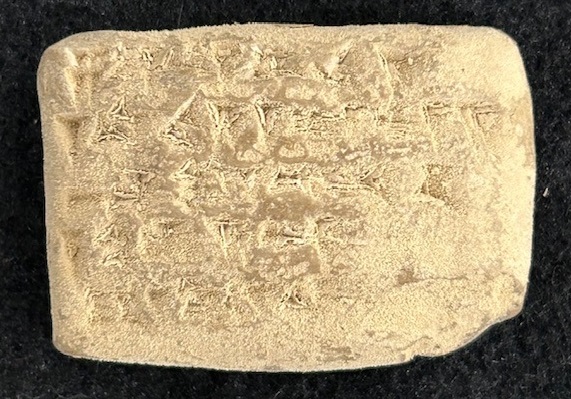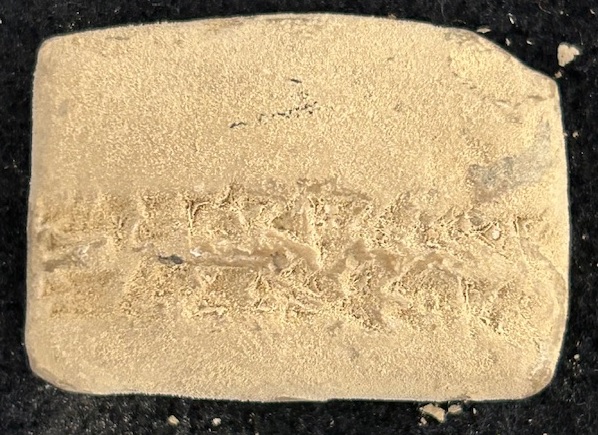Original Babylonian Cuneiform Tablets
Nine Babylonian cuneiform tablets were obtained by Millikin University President A.E.Taylor for the university's library collection on October 12, 1922 from Edgar James Banks (1866-1945), archaeologist/Assyrologist and purveyor of Middle East artifacts. Mr. Banks, in a letter accompanying the collection, certified all nine tablets as being "the genuine ancient Babylonian originals.”
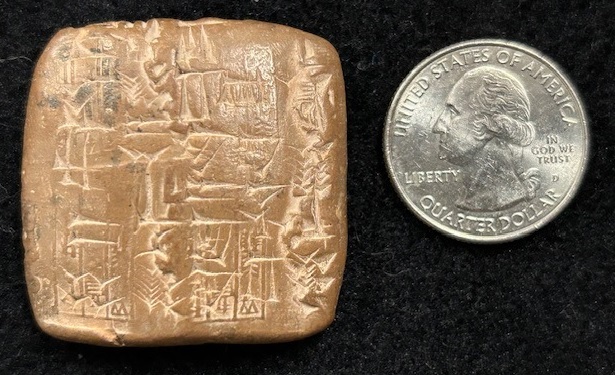
Tablet #5: 1.25" square, next to a U.S. quarter coin for scale. (Cuneiform tablet 5, side A by Amanda Pippitt, CC BY 4.0).
 The tablets originated in several areas of what is now Iraq. (The Tigris and the Euphrates rivers both flow into the Persian Gulf.)
The tablets originated in several areas of what is now Iraq. (The Tigris and the Euphrates rivers both flow into the Persian Gulf.)
Mr. Banks apparently purchased (cheaply) these tablets and a great many others from the local inhabitants who in turn obtained them either from official expedition sites (such as those sponsored by the Universities of Pennsylvania and of Chicago beginning in 1898) or by exploring on their own. Mr. Banks sold such artifacts to a number of academic institutions, libraries, and museums.
It is worth noting that although such exporting of historical artifacts was common and perfectly legal at the time, current laws in most countries would make similar commerce a great deal more difficult, if not impossible, today.
The combined valuation in 1922 currency of the Staley Library tablets was $51.00, which in today's market would equal $547.95 (according to the Federal Reserve Bank of Minneapolis' “What is a dollar worth?“). In comparable dollars, the valuation remains about the same today as it was in 1922, at least judging by a search on eBay on February 7, 2002. That search located 12 cuneiform tablets being sold, and the bids ranged from a high of $102.50 to a low of $17.26 (the latter in poor condition).
Nevertheless, if not the rarest or costliest, these tablets are by far the oldest documents in the Staley Library collection.
The following descriptions are from Mr. Banks' typed notes that accompanied the gift. [Notes in brackets are additions.]
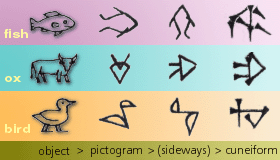 Cuneiform ("wedge-shaped") writing
Cuneiform ("wedge-shaped") writing
Cuneiform writing is the earliest known form of writing. It was developed by Sumerians (in what is now Iraq) over 5,000 years ago from pictograms, that is, stylized forms of drawings of real-life objects. The writing was done on clay tablets with a sharpened reed stylus, and the tablets were then either re-used or else baked if they needed to be preserved. Because it made using the stylus easier, many pictograms over time were turned sideways.
Others adopted this form of writing, including the Babylonians and the Egyptians. It was used for everyday writing, such as in schools and for economic transactions, and then later for literary writing. Some of the latter were kept in libraries.
In 1835 AD, Henry Rawlinson, an English army officer, found some inscriptions in Persia that turned out to be identical texts in Old Persian and Babylonian (cuneiform). By first translating the Old Persian, he was able to begin interpreting cuneiform characters.
Image and information above from University of Pennsylvania Museum of Archaeology and Anthropology.
Below, Egyptian scribes at work, from a relief on the tomb of Ti, at Sakkara, Egypt, 27th century BC.
 “[In the upper middle sits] a scribe with a thick clay tablet supported in his left hand. He has paused for a moment in his writing and raises his right hand with the stylus poised between the thumb and the palm of the hand, the fingers being stretched straight out. When the scribe actually applied the stylus to the clay, he bent all of his fingers and held the stylus in the closed fist.”
“[In the upper middle sits] a scribe with a thick clay tablet supported in his left hand. He has paused for a moment in his writing and raises his right hand with the stylus poised between the thumb and the palm of the hand, the fingers being stretched straight out. When the scribe actually applied the stylus to the clay, he bent all of his fingers and held the stylus in the closed fist.”
Text from Breasted, James Henry. "The physical processes of writing in the early Orient and their relation to the origin of the alphabet." American Journal of Semitic Languages and Literatures, v.32, 1916, pp. 230-249.
Image from McMurtrie, Douglas C. The Book: the story of printing and bookmaking. New York, Oxford University Press, c1943, p.11.
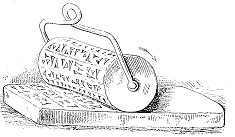 A roller seal, or cylinder seal, made multiple copies:
A roller seal, or cylinder seal, made multiple copies:
The cylinder seal was also used to certify authenticity of documents, see tablet #5 above.
Many hundreds of thousands cuneiform tablets and tablet fragments have been preserved and are now found all over the world in museums, libraries, and private collections.
From University of Birmingham, England, Cuneiform Database Project.
Notes February 7, 2002, by Karin Borei, Staley Library Director (1999-2008). This page created by Karin Borei, February 7, 2002.
Updated with new photographs by Amanda Pippitt, Staley Library Director (2021-present), March 25, 2025. All cuneiform photographs (tablets 1-9) by Amanda Pippitt, licensed under CC BY 4.0.
1. Found at Drehem, a suburb of Nippur, where there was a receiving station for the temple of Bel. [Nippur was for thousands of years the religious center of Sumerian Mesopotamia.] This is an unusually perfect tablet, slightly larger than the average. The inscription is the record of the receipt of one sheep and one goat for the sacrifices to a certain god, and six other sheep and goats for the same person [god?] from a different individual, all delivered on the 30th day of the month. On one edge of the tablet is the numeral 8, the total number of the animals received. The tablet is dated at the bottom of the back or rounded side about 2350 B.C., or early in the Ur dynasty of kings who ruled from about 2400 to 2100 B.C. [1.5" x 1.25".]

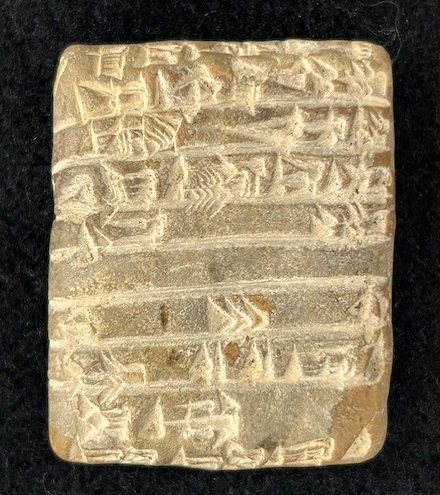
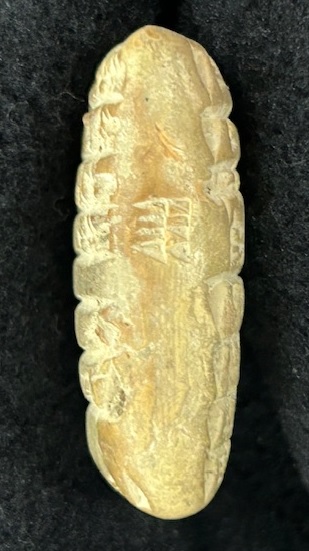
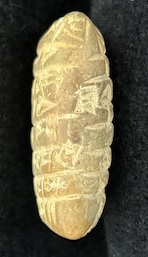
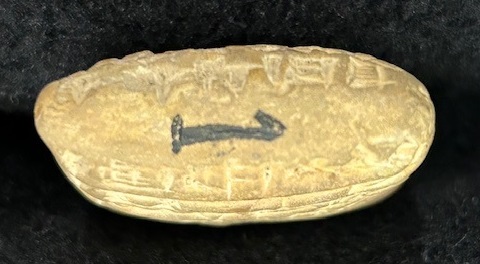
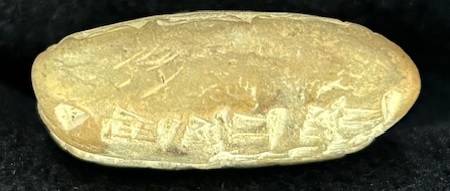
2. Found at Drehem. A bill for one sheep delivered on the 26th day of the month. Dated about 2350 B.C. [1.25" x 1".]
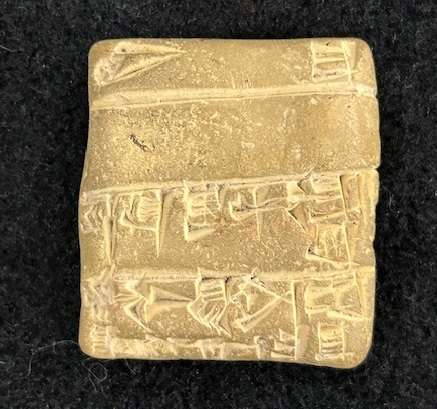
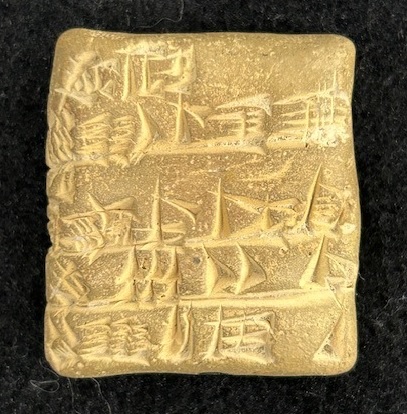

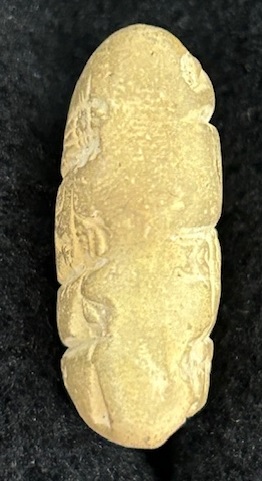
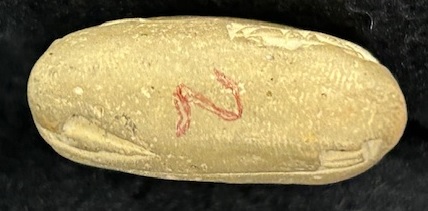
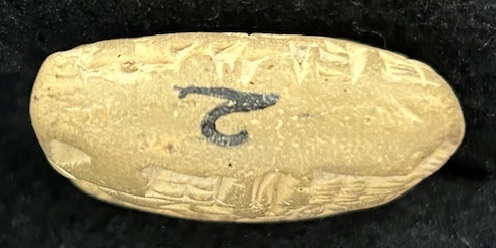
3. Found at Drehem. A butcher's bill for 1 sheep, 1 ram, 1 she goat, 4 lambs, 1 ewe, and 1 milk fed lamb, all killed for market and delivered on the 26th day of the month. On one edge is written "9 sheep," the total number of the animals. Sheep and goats were all counted as sheep in making a summary. This was the usual custom. It is dated about 2350 BC. [1" square.]
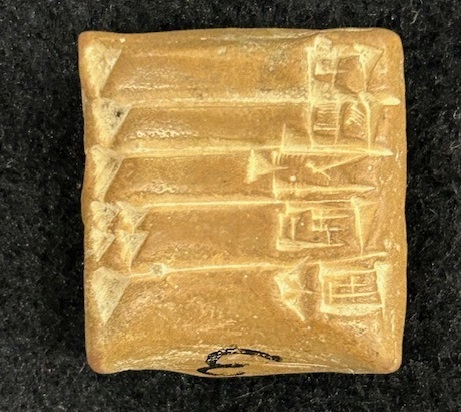
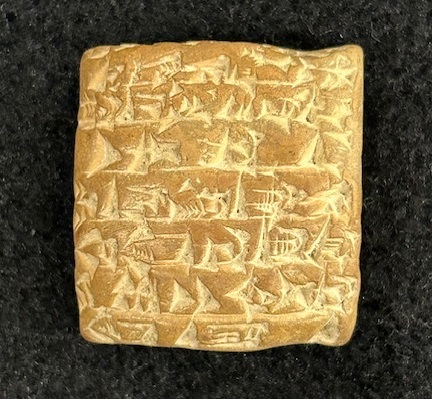
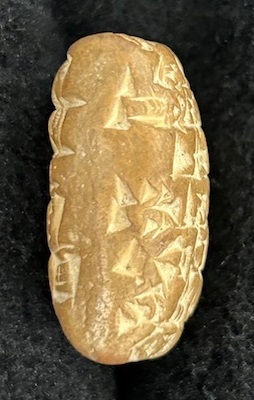
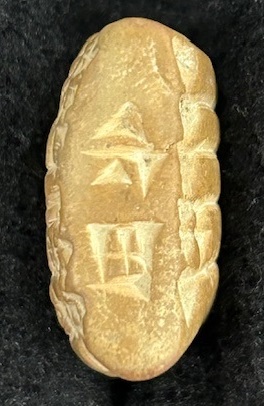
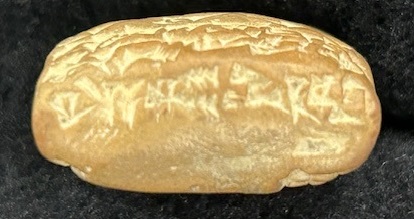
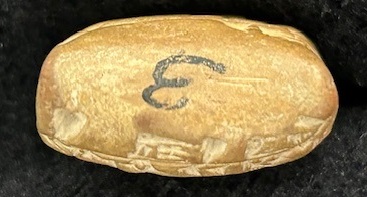
4. Found at Nippur. This is a very ancient tablet, as shown by the numerals which are half circles, and the other characters are nearly hieroglyphic from which the [cuneiform] wedge signs developed. The inscription is a memorandum of merchandise. It is not dated, but the writing shows it to come from the time of Sargon I, 2800 B.C. or earlier. Few tablets of greater antiquity have ever been discovered. [1.5" x 1.25".]
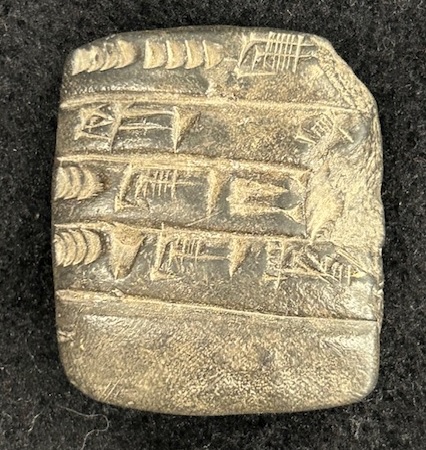
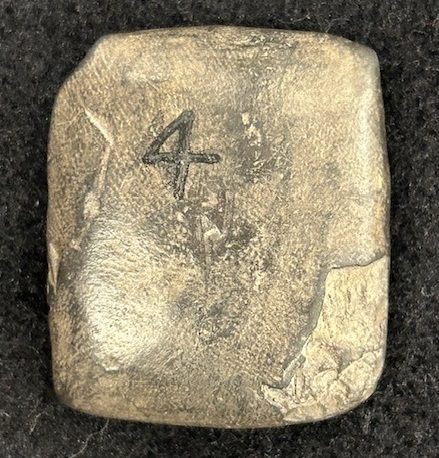
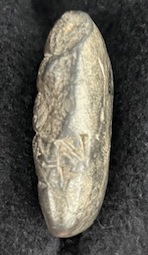
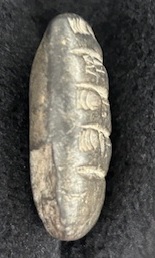
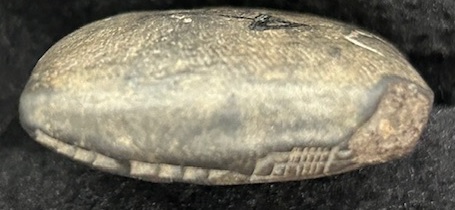
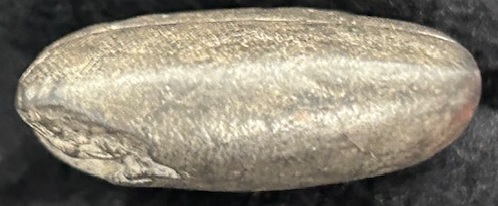
5. Found at Jokha, the ruin of the ancient city of Umma in Central Babylonia. This is a typical temple record of the offerings. After the tablet was written, and while the clay was still soft, the temple scribe rolled over the entire tablet his cylindrical stone seal, and the seal impression made it impossible to change the record. The seal impression bears in raised characters the name of the scribe and of his father, the seated figure of a deity and the standing figure of a priest. The tablet is dated about 2300 B.C. [1.25" square.]
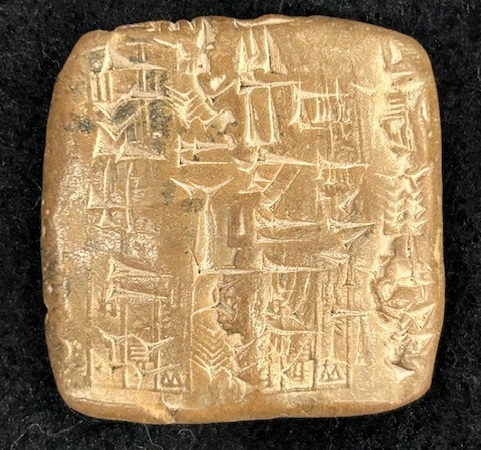
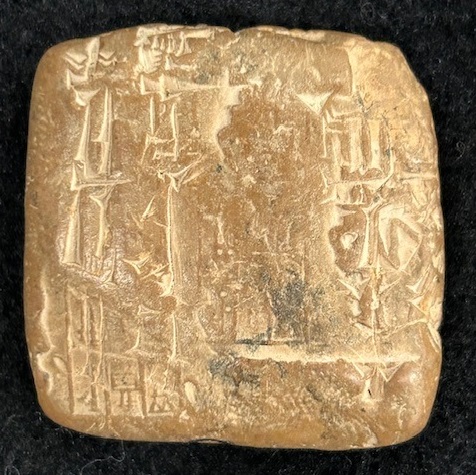
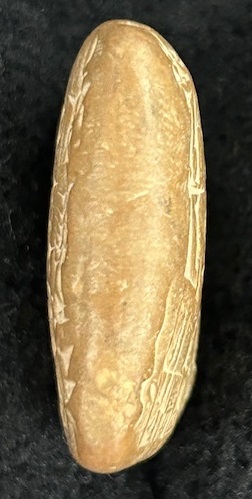
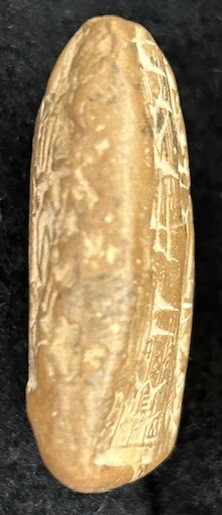
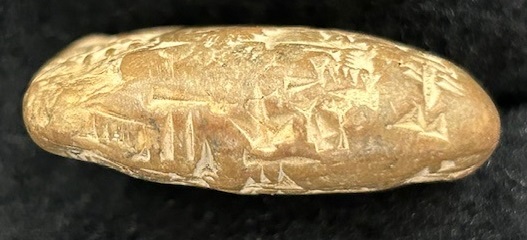
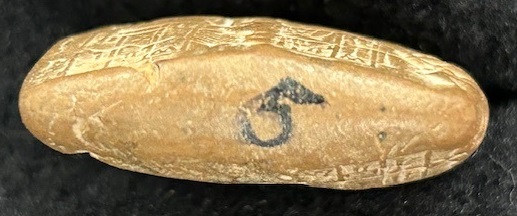
6. Found at Jokha. A temple record, sealed and dated about 2350 B.C. [1.5" square.]

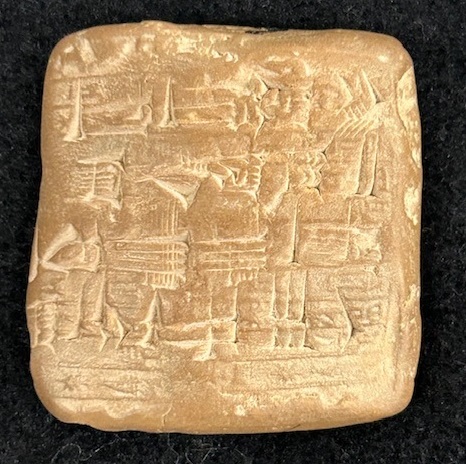
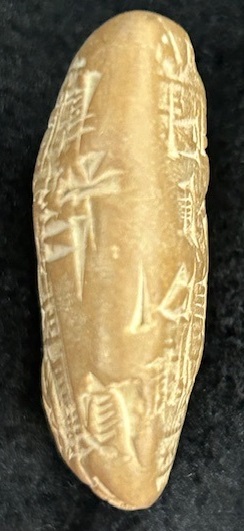
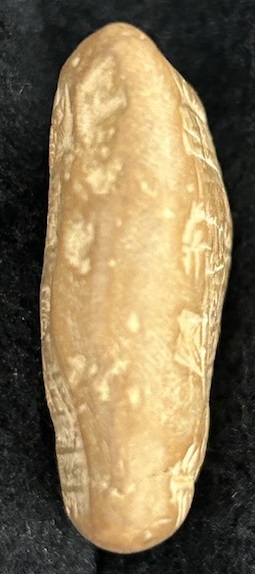
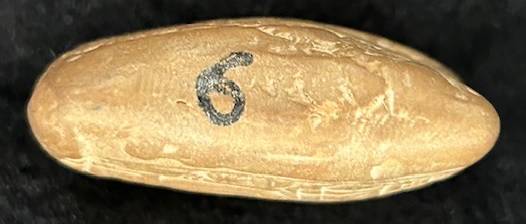
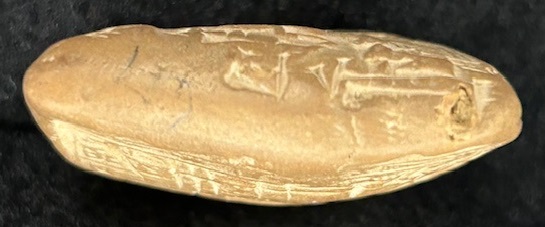
7. Found at Drehem. A temple record of the offering of 2 oxen, sealed and dated about 2350 BC. [1.75" x 1.25".]
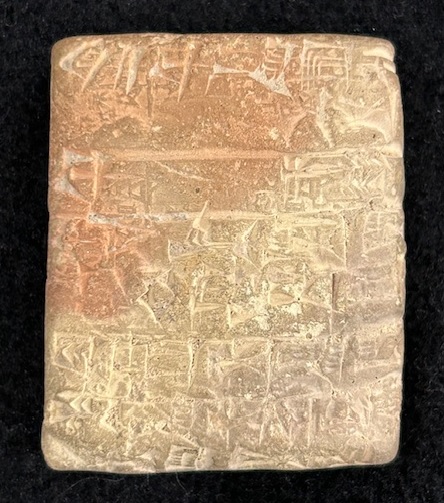
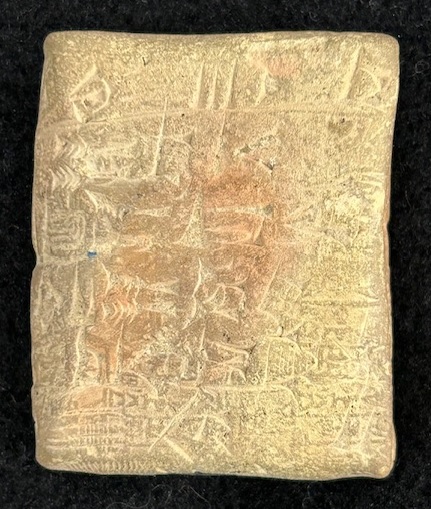
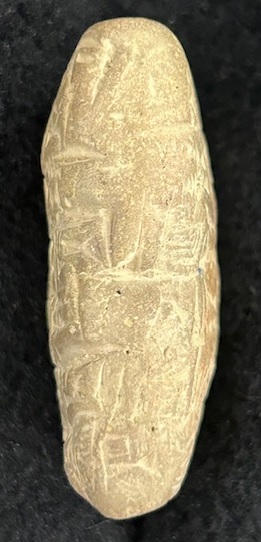
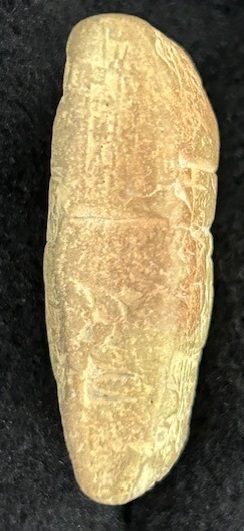
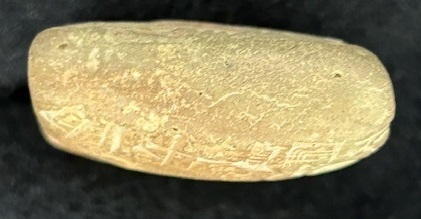
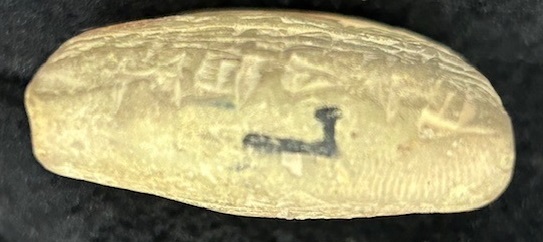
8. Found at Warka, the ruin of the Biblical city of Erech mentioned in Genesis 10:10. This is a votive tablet made by the priests of the temple of Goddess Ishtar, the goddess of love, and sold to the visiting pilgrim, who presented it to the temple as an offering for the king. Thus a part of the temple income was derived. The inscription reads: "For Sin-ga-shid, the mighty hero, king of Erech, King of Amanu, in the temple of the Goddess Ishtar which he built in the royal residence of his kingdom." The date of this king, and therefore the tablet, is about 2100 BC." [The size is 2" x 1.75". Unfortunately, cracked at the lower edge.]
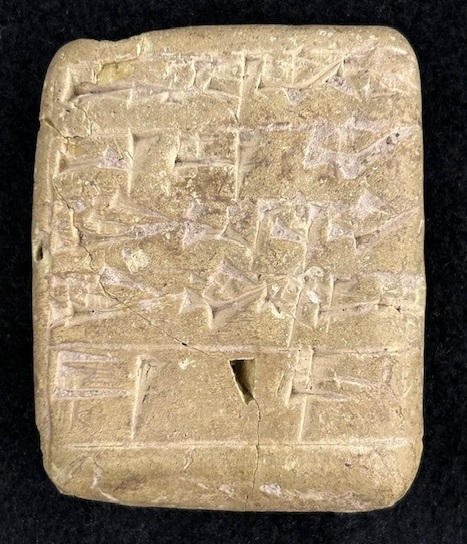
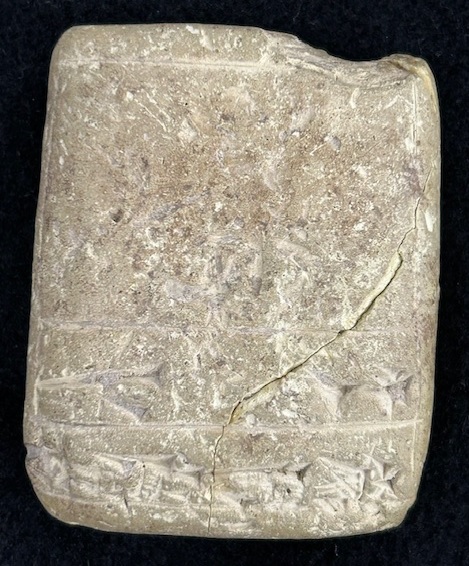
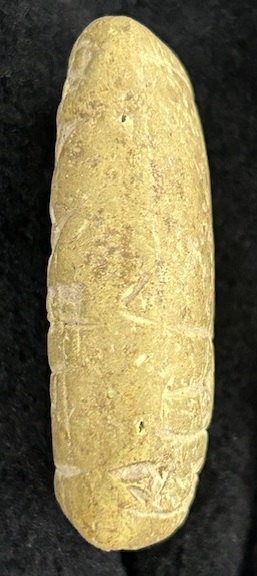
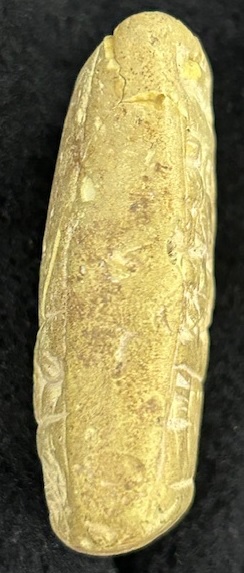
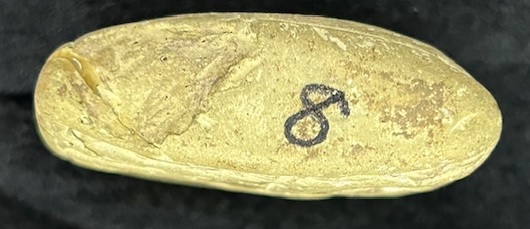
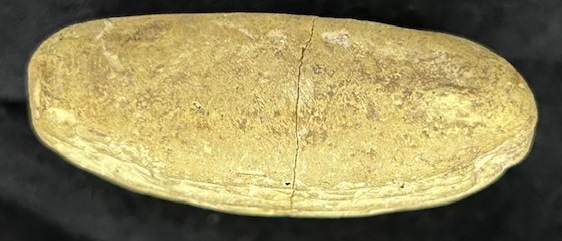
9. Found at Babylon. This is a late or neo-Babylonian tablet or contract of the usual shape and size. It relates to five manas of gold paid by one man to another for merchandise. It is dated in the two lines on the back as follows: "The month ?, the day 17, the year 11 of Nabonidus, king of Babylon." Nabonidus, the last Semitic king of Babylon ruled from 555 to 538 B.C. Therefore the tablet was written in the year 544 B.C. Nabonidus was the father of the Biblical Belshazzar who is said to have seen the writing of the hand on the wall. [1.5" x 1". Tablet in poor condition.]
